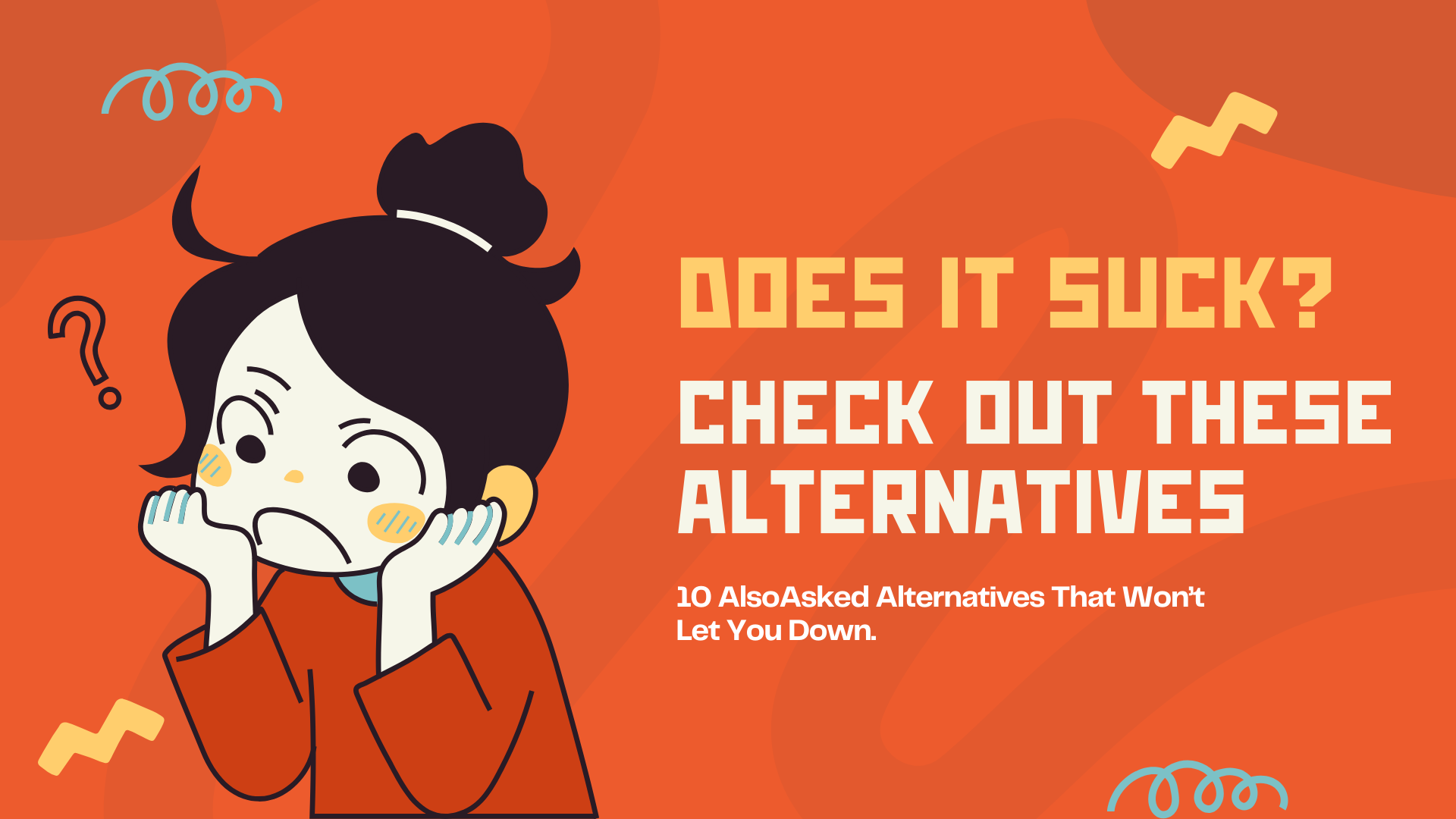
Search Intent, User Intent, Keyword Intent—What the Heck!
Welcome to my ultimate guide about Search Intent, User Intent and Keyword Intent. Let me first introduce myself briefly and let you know why I care about this topic. Obviously, I am a keyword research enthusiast; after all, I am the founder of one of the most used and trusted keyword research suites of tools, Allintitle.co. I launched Search Intent as a feature for Allintitle.co almost 2 years prior to Ahrefs doing it for their platform. While building the Search Intent feature for Allintitle.co and since, I’ve done extended research on this topic, and here I will share that knowledge with you. I will also try to define a general vocabulary around this topic for terms that people sometimes use interchangeably, such as Search Intent, Keyword Intent, User Intent, Adjacent Intent, Intent Proximity, etc., where I think a little bit of precision in definitions should make everyone’s life much easier. Everything I’ve learned about Search Intent, all the mistakes I’ve made (I made a lot, maybe more than anyone else,) and how I could overcome them by going to the roots of the problem and creating a precise definition of the subject matters will be covered here. Let’s get started.
Search engines like Google aim to rank pages that users find helpful, which is how it can retain its users and why people want to continue using one search engine over the other.
Google and likewise other prominent search engines have evolved beyond showing just relevant results that match a keyword term in simple 10-blue link pages. Now, the goal is more than mere keyword-focused relevancy; it is to display pages that better fulfill the intent behind the user’s search.
When satisfying the user’s search intent is a top priority for search engines like Google, creating content that ranks high and thrives on search results can very much depend on primarily identifying the right intent and then trying to address that intent with content that can satisfy it in the best possible way.
Even correctly identifying the keyword intent type does not always guarantee that the search intent can actually match the user intent. Take “buy Apple” as an example. Search engines can correctly classify this as a transactional intent (because of the term buy in the keyword). Google search results for “buy Apple” 100% feature Apple products, but the user might simply mean the Apple fruit and not the Apple computers or phones.
What’s the difference between Keyword Intent, Search Intent, and User Intent?
Search Intent, User Intent, and Keyword Intent are most often used interchangeably, although they can slightly refer to different notions.
It always starts with a keyword. A keyword has an implied intent connected to it. This implied intent is called Keyword Intent. Now, let’s say someone searches for that keyword on a search engine. Now, the intent behind the action of searching a keyword on a search engine can be thought of as the user intent and the intent that the search engine understands from it as the search intent.
So intent can be the intent perceived from the keyword itself, the intent the user has in mind when searching that keyword on search engines, or the intent that search engines understand from that search term, which becomes evident from the results they return. These three intents can all be the same and of the same type, or they can be different.
Although we can guesswork the user intent with a good degree of precision, it’s not always crystal clear what the user intent behind a search term is. Let’s see an example.
“Podium” as a keyword could have a navigational keyword intent (you know, the Podium Software.) But it can also imply the Podium, the physical product itself. So, the keyword intent could be Navigational or Informational/transactional.
When you search “Podium” on Google, the first link is Podium as the software, but the second link is the Wikipedia article about Podium, the physical product, and the third link is Podium products on Amazon, followed by Podium as the physical product images. So, the search intent is somewhat navigational, Informational, and transactional. Consequently, the user intent would be vague as it can fall under any of the above three intents.

The caveat here is that although search intent can fall under multiple categories simultaneously, the user intent is most often unique, meaning that the user can’t have, for example, both transactional and informational intent at the same time.
Now, if we change that to “buy podium,” just by including the “buy” modifier, the keyword intent changes to transactional. Because the word buy generally implies the user is ready to make a purchase.
If you Google “buy podium,” you will notice that the search intent has now changed to almost 100% showcasing podium as the physical product, with many product links from Amazon and other e-commerce platforms. So now the search intent has shifted to pure transactional, too.

Likewise, the user intent for “buy podium” is also transactional, as in either case, they want to buy something, which implies a transactional intent type. However, their actual intent still might be vague as they might still mean to buy the Podium as the software or the podium as the physical product.
Defining Keyword Intent, Search Intent, and User Intent
So now let’s try to define Keyword Intent, Search Intent, and User intent:
- Keyword Intent: This is the intent that can immediately be perceived from the keyword itself. A keyword can have more than one implied intent.
- Search Intent: Search intent can refer to the underlying motive behind a user’s search query as perceived by search engines. In other words, this will be the intent that the search engines associate with a searched term, which depends on how well search engines can understand the semantic meaning behind each keyword or keyphrase. Just like keyword intent, search intent can fall under multiple categories at the same time. For example, the term “RBC Bank” can have both navigational and informational search intents. When you Google “RBC Bank,” it shows the nearby RBC branches (serving navigational intent) as well as a knowledge panel and link from Wikipedia (serving the informational intent.)
- User Intent: This is the intent that the user has when looking up a keyword on search engines; it can be vague and sometimes misunderstood by the search engines, which can lead to the user refining their keyword to get to the correct result that better matches their intent. User intent, more often than not, falls only under one intent category. Take “Snow Removal” as an example; it’s not clear whether the user needs snow removal services or snow removal equipment.
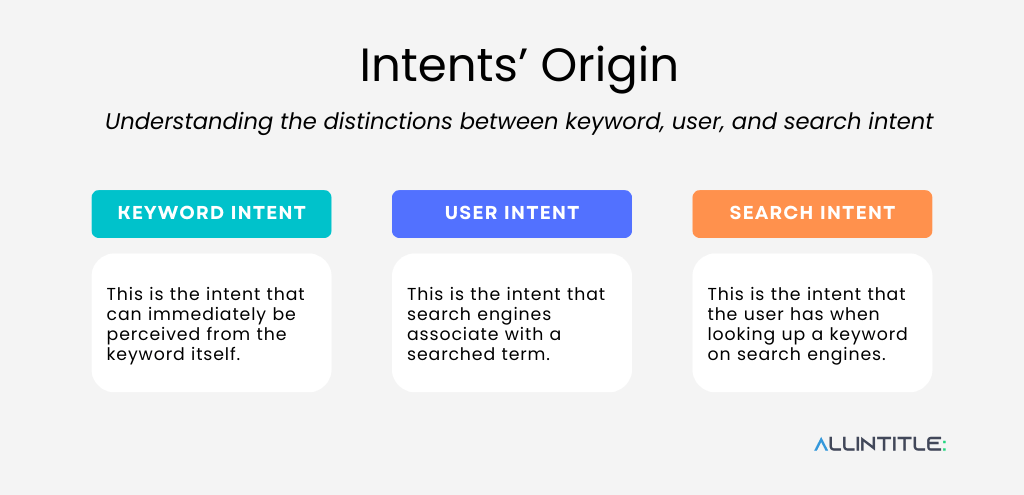
Imagine the example of “running shoes”; the search term is broad, and although as a keyword, we can still classify that as both having an informational and commercial intent, the real user intent is more or less vague as we don’t know what the user is exactly trying to accomplish. When searching “running shoes” on Google, we can see that search Intent is mostly transactional as Google shows products from different brands, e-commerce sites, etc.

Why Is Keyword Intent Important for SEO?
Understanding and optimizing for search or keyword intent lets you align your content marketing strategies with the user’s intent so that your content can better address their needs and match the state of the customer journey they are currently in.
Optimizing for search intent is more than just targeting keywords that are related to the topic you are writing about. The goal is to address the underlying needs of the users by providing a satisfactory answer that aligns with the true motive behind their search.
Targeting the right keywords is important for SEO, but targeting the right intent is even more important. Sometimes, you create a great, well-optimized web copy or blog post, and you wonder why it is not doing well on search results; the answer could be that the article is not intent-optimized.
Remember that the goal of the content you create must, first and foremost, be to address the specific intent behind users’ search queries but still we work with search engines that although are getting better in understanding user’s intent and keywords semantic meanings, they derive these understanding from the search query you provide them with. So it could become very tricky.
Let me give you a simple example. Imagine you want to target this keyword “when first to see an orthodontist.”
This keyword has an informational intent, meaning that people searching it should be seeking an answer to a specific question without any intent to buy anything right now (we will cover this later).
Now you write an article with this main headline: “Why is seven the right age to see an orthodontist,” the keyword intent is informational, and the idea you are proposing with the main headline is 7 being the right age for the first visit to orthodontist. Your article provides the right answer to the question, so it should do very well intent-wise.
Now let’s think about it again.
Our article provides the answer right on its headline, let’s say you use the same headline as the title tag or Google rewrites it to your main headline. That means anyone seeing this article on Google does not even need to click to visit our page to find the answer there. That means the click-through rate will be low.
On the other hand, generally, when people naturally want to know what the best age for anything is, they start searching with keywords that start with “what age” or “when.” So, for this particular example, the search terms are also “when first to see an orthodontist” or “at what age to see an orthodontist.” Now Google might better associate and reward headlines or title tags that are formatted to align with how people search to find the best age for doing something.
That means the headline of our article could better be reworded to say something along these lines: “What Age Should Children See An Orthodontist?” or “When Should Your Child See an Orthodontist?” rather than presenting the answer (7 as being the right age) and then mentioning why that is the case.
Both headlines very well answer the intent of the user but one can work better than the other.
The point is that search intent can be thought of as the bridge between the keyword intent and the user intent. That’s how Google and any other search engine try to fill the gap between a keyword and the user intent. Remember that Google and other search engines, although getting better as time goes by and technology gets more sophisticated, still have limitations to precisely fill this gap in all cases.
Search engines use different techniques to provide a result that can fully or at least partially answer the user search intent even for the most difficult keywords (intent-wise.) Some of these techniques include
- Presenting diversified results
- Considering current trends
- Considering seasonalities
- Entity analysis and popularity of the branded terms
- Search stream history (by this, I mean how users refine their search after searching a broader term and not finding the result they were looking for.)
What Are Intent Clusters
Clustering in SEO is related to categorizing items with common characteristics or properties, as it is easier to understand and work with groups of similar items rather than scattered ones.
In SEO, the items that are commonly clustered can be just anything from pages, content, topics, and keywords to links, anchor text, etc.
You might want, for example, to cluster keywords into groups based on their lexical wording (common words in them), their entity types (mention of the common entity in them), their intent (having a similar intent), or even semantically (common meaning.)
Clustering based on intent can be done by grouping related keywords into groups that target the same intent. Clustering can also be done in two dimensions; for example, you can cluster keywords based on their intent and lexical wording simultaneously.
Another way intent clustering can be done is based on keywords with adjacent intent, which I will explain in the next section.
Adjacent Intent or Intent Proximity
Keywords with adjacent intent are those long-tail keywords that the user will move onto searching after first searching a broad term as they move along the customer journey funnel or as they refine their search to get to the correct result they were expecting.
Keywords with adjacent Intent might fall under different intent categories, and that happens most often when the main keyword is broad and falls under more than one intent type or when the user asks a follow-up question as they are ready to shift from one customer journey stage to another (for example the shift from informational intent to transactional.)
Google’s People Also Ask (PAA) feature could be a great place to investigate and find topics or keywords with adjacent intent.
With the PAA feature, Google displays a list of questions related to each search term. These questions can fall under one or several intent types, and as you click on each question, it adds more questions, trying to help the user see the same topic from different perspectives and sometimes navigating from more general questions to more specific, decision-making ones.
For the “running shoes” example, here are the PAA questions that Google returned at the time of writing this article:
- What type of shoe is best for running?
- Do I need running shoes for a 5K?
- Are Nike Air Max good for running?
- What are the most comfortable running shoes?
These long-tail questions with more precise intent are what Google believes will be the next logical questions the user might ask. Thus, these are the keywords with adjacent intent. Google presenting a set of adjacent intent keywords can help the search intent get closer to the user’s actual intent.
In that perspective, Google’s People Also Ask feature is kind of like a clustering engine that groups topics or questions based on their intent proximity.
Remember that there are some limitations related to using the People Also Ask feature of Google for this purpose. Two important ones are:
They are not always up to date (not always reflecting the current trends). One example is the keyword “Hurricane Milton.” Many people were searching Google for questions related to this catastrophic event, but Google didn’t provide any PAA feature for this search term at the time.
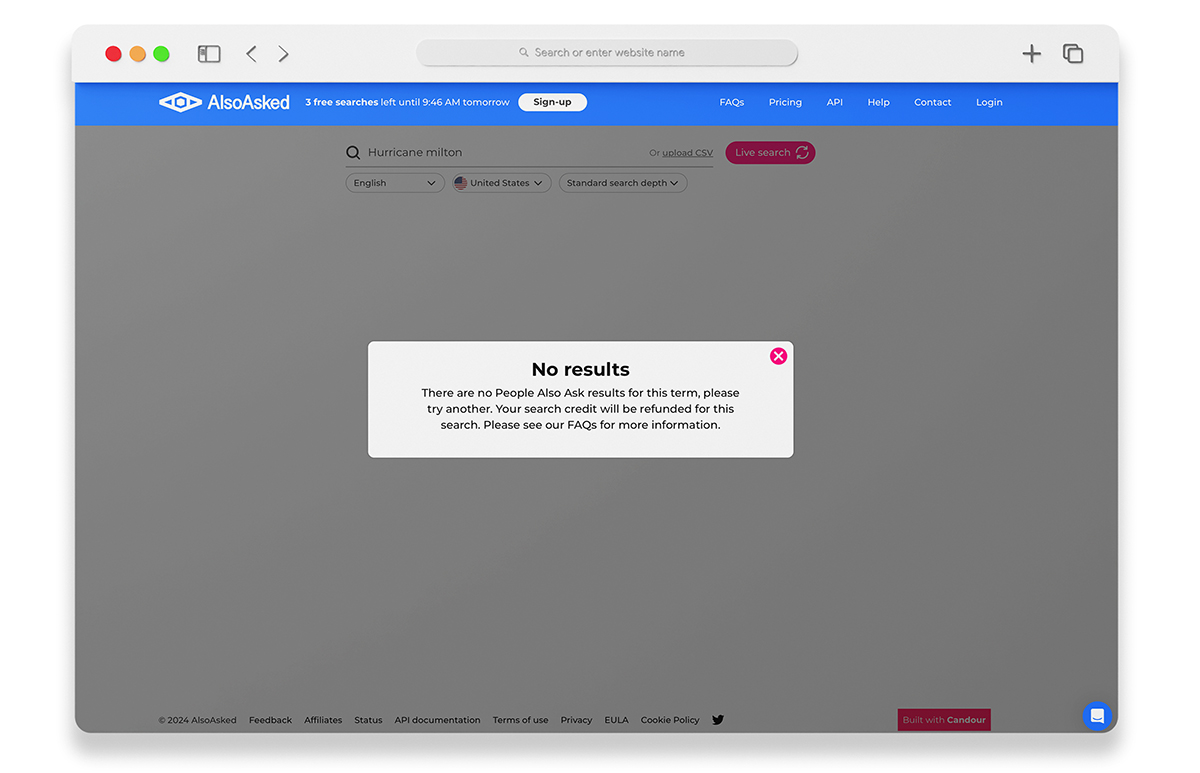
They can be easily manipulated. You can actually include any question you want as a PAA question by just searching for it a few times in a couple of months and having that question answered somewhere on the web.
Allintitle’s People Also Ask tool is one of the best tools to extract these adjacent intent PAA questions not only from Google but also from Bing and Yahoo helping you to cluster them based on their intent proximity.
Conversion Funnel and Keyword Intents
Because the conversion funnel is reflective of the customer’s journey from information gathering to making a purchase and the intent types are also defined and categorized using the same progression (except maybe the local and navigational intent types), we can, to a good degree, align each intent type with one stage in the conversion funnel.
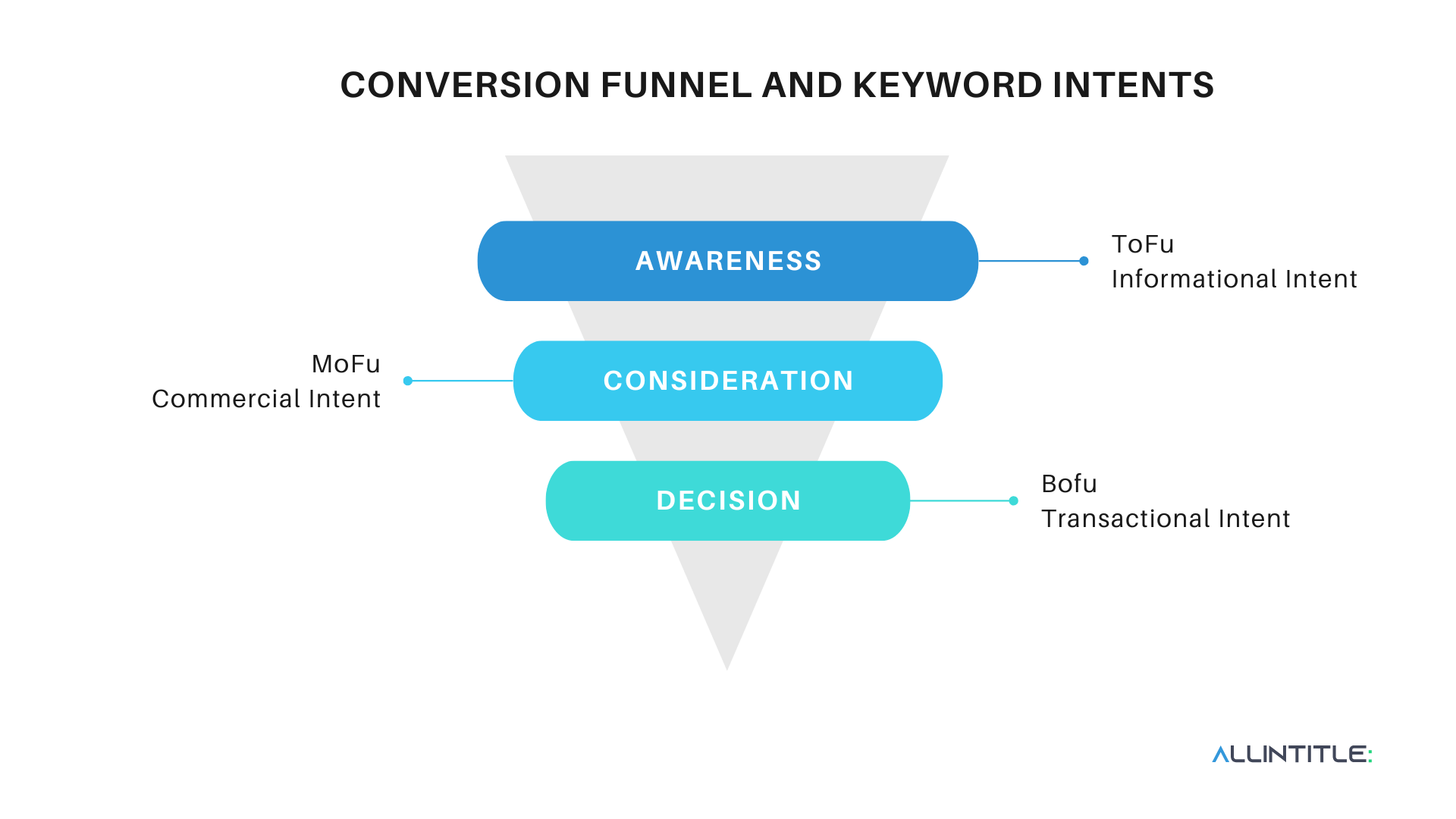
Keywords with informational intent are well suited for top-of-the-funnel (ToFu) content marketing tactics and are best for brand awareness. This is because with the informational intent, users seek insights about particular problems or pain points and thus try to find answers to their questions, but they are not yet ready to commit to any buying decision.
Informational blog posts with less focus on selling your product or services fall under targeting informational user intent.
Similarly, keywords with commercial intent are well suited for Middle of the Funnel or MoFu tactics. At this stage in the customer journey, users are well-versed in the topic and are in the consideration stage.
Content focused on product reviews, feature listicles, and comparison guides aligns with this type of keyword intent and the MoFu stage.
In the same manner, keywords with transactional intent are better suited for Bottom of the Funnel or BoFu content marketing tactics. At this stage, users are actively trying to find a solution for their problem, and they are in the buying mode.
Focusing on content that gives limited-time offers or discounts, free demos, money-back guarantee use cases, or things that set you apart from the competitors is in line with the BoFu marketing tactics, and finding keywords with transactional intent can be a starting point to develop such strategies.
Remember that at this stage, you are selling your product or services, so you need to address how your product and services address their pain point, why your offering is better than the alternatives, and provide them with all the reasons they need to become your client.
Types of Search Intents
Search intent can fall under the following five categories. Remember that a keyword can simultaneously fall under more than one intent type. This is explained with a few examples under the section “Search queries with multiple intents.”
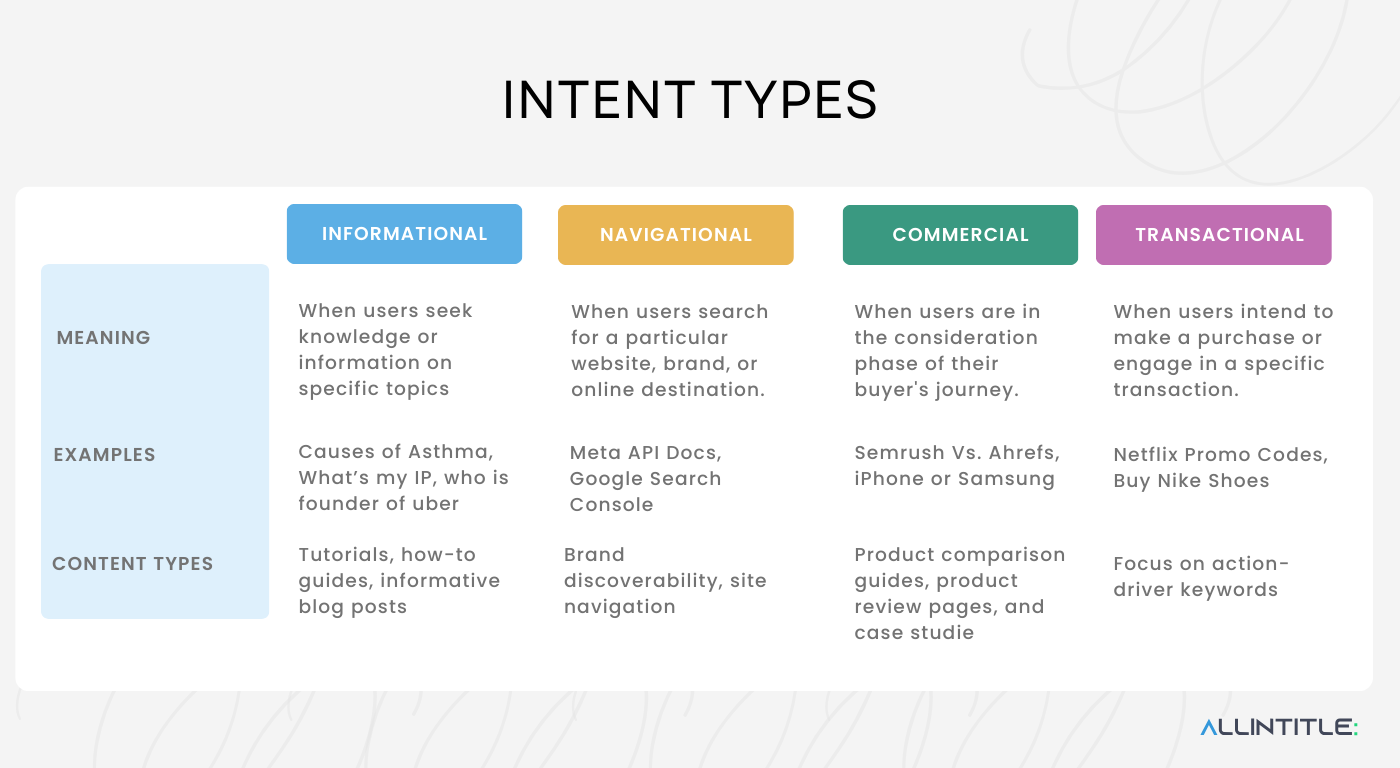
Informational Intent
Informational search intent is when users seek knowledge or information on specific topics. They look for general facts, definitions, tutorials, how-to guides, or explanations. People with informational intent have a specific question or want to know more about a certain topic.
To serve informational search intent, you can create informative blog posts, guides, or videos offering valuable and accurate information. Information intent content is normally the top-of-the-funnel type of content.
Navigational Intent
Navigational search intent is generally related to when users search for a particular website, brand, or online destination.
People with navigational intent want to visit a specific website. For example, people who search for “Facebook” are usually on their way to the Facebook website.
You generally want to optimize for navigational intent to ensure website or brand discoverability. Remember that ranking high for a navigational term is mainly beneficial if your site is actually the site people are looking for; otherwise, you might receive irrelevant clicks that lead to a high bounce rate.
Commercial Intent
Commercial intent, or better said, commercial investigation search intent, indicates that users are in the consideration phase of their buyer’s journey.
Some people have the intention to buy in the (near) future and use the web to do their research. They are looking for information that helps them make an informed decision when they’re still investigating their options.
You can target commercial investigation keyword intents by targeting product comparison keywords. You can do this by creating product comparison guides, product review pages, and case studies.
By providing content optimized for commercial intent, you help people make informed decisions, introduce your brand, and lead them to your sales pages when they are ready to buy.
Transactional Intent
Transactional intent is another type of search intent where users intend to make a purchase or engage in a specific transaction. Many people buy stuff online and browse the web to find the best purchase.
People with transactional intent are searching with the purpose of buying something at that moment. They often already know exactly what they want to buy and just want to get to that product page right away.
These searches include keywords like “buy,” “deal,” “discount,” or “product names.” Optimizing for transactional intent requires focusing on the bottom of the funnel content with proper use of action-driver keywords.
Local Intent
Local search intent is prominent among users seeking products or services in a specific geographic location. These searches include location-based keywords such as “near me” or “in [city name].”
Optimizing for local search intent entails claiming and optimizing a Google My Business listing, ensuring accurate contact information, optimizing your N.A.P consistency and accuracy, and getting more reviews online reviews.
How to Determine Keyword Intent?
Check Keyword Modifiers: The easiest way is to check the keywords modifiers, modifiers like “How to”, “What is”, “Why”, “Who”, “Benefits of”, “History of”, “Facts about” can indicate an informational intent while modifiers such as “Login”, “Sign in to”, “Access”, “Support”, “Official website of” are indicator of navigational intent. Likewise all brand names can indicate an navigational intent.
Modifiers such as “Buy”, “Order”, “Deal”, “Discounted”, “Coupon code”, “Purchase” can be indicative of a transactional intent and “Best”, “Top”, “Reviews”, “Comparison”, “Pros and cons”, “Is it worth it”, “Benefits of”, “Which is best”, “Vs.” or “Versus” can reveal a commercial intent.
“Near me”, “In [location]”, “In [city]”, “In [neighborhood]”, “Around [landmark]”, “Services in [location]” can also indicate a local intent.
I have summarized these indicators in the table below:
| Search Intent | Indicator Words (modifiers) |
| Informational | “How to”, “What is”, “Why”, “Who”, “Benefits of”, “History of”, “Facts about” |
| Navigational | “Login”, “Sign in to”, “Access”, “Support”, “Official website of” |
| Transactional | “Buy”, “Order”, “Deal”, “Discounted”, “Coupon code”, “Purchase” |
| Commercial Investigation | “Best”, “Top”, “Reviews”, “Comparison”, “Pros and cons”, “Is it worth it”, “Benefits of”, “Which is best” |
| Local | “Near me”, “In [location]”, “In [city]”, “In [neighborhood]”, “Around [landmark]”, “Services in [location]” |
Analyze the SERPs: One way to determine search intent is to manually analyze the search engine results pages (SERPs) for your target keywords. By analyzing the SERP features, the words used in the title tag of the top-ranking sites, and the nature of the sites, you can identify the intent that search engines attribute to those keywords.
This table summarizes the SERP Features and what search intent they can indicate:
| Search Intent | SERP Features |
| Informational | Featured Snippet, Knowledge Graph |
| Navigational | Site Links, Site Search Box |
| Transactional | Shopping Ads, Product Carousel |
| Commercial Investigation | Comparison Table, Reviews |
| Local | Local Pack, Map Results |
Other than the SERP features, the existence of certain sites can be indicative of a certain Intent type. For example, the existence of links from e-commerce sites in search results, such as sites like Amazon, Walmart, Etsy, or Shopify stores, can show a strong transactional search intent for that keyword. On the other hand, if Wikipedia appears in the very first few results, it can reveal an informational search intent.
Using Keyword Research Tool: You could also use a keyword research tool that provides search intent information. Tools like Allintitle’s KW Explorer not only help you identify popular keywords and phrases related to any topic or seed keyword but also provide you with the Search Intent information for those keywords.
Using AI Tools: Gen-AI or LLM tools like ChatGTP are also great for analyzing the intent behind each keyword. ChatGPT, Claude, or Gemini can provide valuable insights into the keyword intent (always verify the information you receive from a language model.)
Is Intent Dynamic or Static?
Keyword intent is, for the most part, static rather than dynamic, meaning that keywords have stable intent categories that won’t change over time. For example, queries like “weather today” (informational) or “buy iPhone 13” (transactional) are highly unlikely to change to other types of intent over time.
Although the keyword intent may stay intact, the user intent, which is what people expect from a query, can shift due to factors such as trends, seasonality, technological changes, behavioral shifts, and the emergence of new brands, new technologies, or new products. For example, “holiday gifts” can vary depending on the time of year. For instance, during a pandemic, the search intent behind “travel restrictions” could change dramatically. Take “Ryobi” as an example. People searching for this brand around May are most likely interested in their mower products, and people searching in November are most likely interested in the Snow Removal equipment.
The search intent, which is how search engines interpret user intent from a keyword, can also change due to facts like algorithm updates and the emergence of new brands, products, and technologies.
Understanding Search Intent Transitions
Slight changes in the keyword term can change search intent from one type to another. Users can transit from one intent to another based on the search journey stage they are in at each time.
These transitions often reflect how users often move from gathering information (informational) to evaluating options (commercial investigation) and finally taking action (navigational or transactional).
For example, a user can start by first searching “Is invisalign effective” (informational), then go to “Invisalign vs. Braces cost comparison” (commercial), and then finally search for “top invisalign provider near me” (transactional.)
Other than the buyer journey transition, where the user moves down the conversion funnel, all sorts of other transitions can also happen. Here are some examples of search intent transitions:
1. Informational to Commercial Investigation:
- “How to lose weight” (Informational) – “Best diet plans for weight loss” (Commercial Investigation)
- “Benefits of yoga” (Informational) – “Top yoga mats for beginners” (Commercial Investigation)
2. Navigational to Transactional:
- “Etsy” (Navigational) – “Christmas gifts Etsy ” (Transactional)
- “Amazon” (Navigational) – “iPhone 12 Pro Max Amazon” (Transactional)
3. Informational to Local:
- “Is poulet rouge halal” (Informational) – “Poulet rouge restaurant West Island” (Local)
- “Do plumbers fix water heaters” (Informational) – “Plumbers near me” (Local)
- “Are there braces that go behind your teeth” (Informational) – “Behind the teeth braces near me (Local)
4. Commercial Investigation to Transactional:
- Laptop reviews and comparisons” (Commercial Investigation) – “Buy Lenovo laptop” (Transactional)
- “Best online flower delivery services” (Commercial Investigation) – “Order flowers online (Transactional)
5. Commercial Investigation to Navigational:
- “Best noise-canceling headphones” (Commercial Investigation) – “Bose QuietComfort 35 II” (Navigational)
- “Top 10 smartphones” (Commercial Investigation) – “iPhone 13 Pro Max” (Navigational)
Remember, it’s always helpful to align your content strategy to address the different intent that users might have in their search journey. You can tailor your content to address a search intent transition that the users normally have. For example, this can be done by providing valuable information about a topic, then guiding users in their decision-making process, and then providing different options they can choose from and linking to the product pages, making it easy for them to take the desired actions.
This could mean that by optimizing for search intent transition, you might be able to cater your content to people who might have different types of intent at the same time and with the same content. Though I am not sure how practical this method could be, you might want to leave a comment for me below if you had success with this approach.
Search Queries With More Than One Intent
There are keywords that can have more than one intent. Normally, these keywords fall under one of the following categories. For multi-intent keywords, only the user knows what they are actually looking for. Search engines try to find out the actual user intent by considering trends, context, seasonalities, user behaviors, and search history to return the most relevant and valuable information to users.
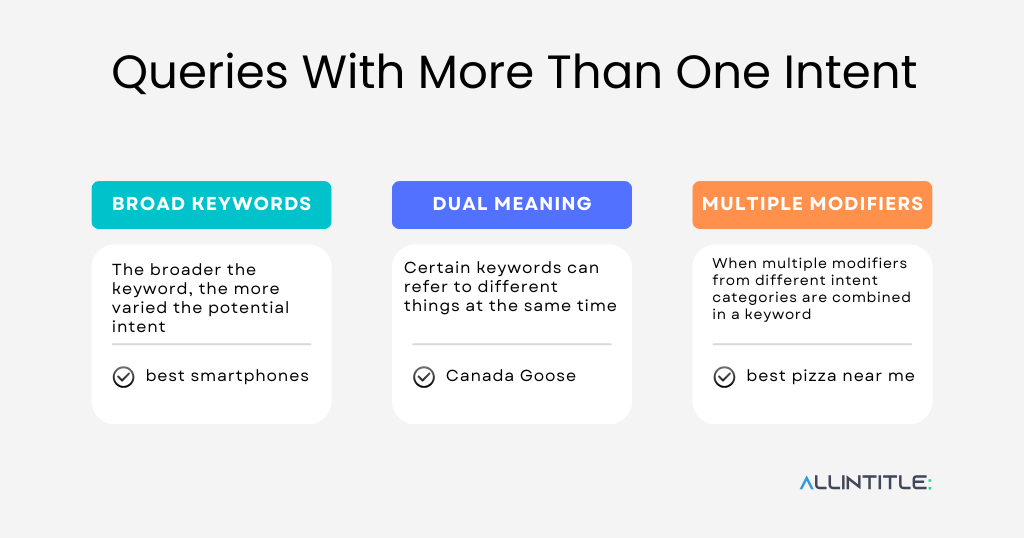
- Broad keywords: The broader the keyword, the more varied the potential intent. For example, a search for “best smartphones” could imply informational intent (seeking reviews or comparisons), commercial investigation intent (comparing options before buying), or transactional intent (looking to purchase a smartphone). Other examples are “running shoes”, “python” or “vacation plans.”
- Keywords with Dual Meanings: Certain keywords can refer to different things entirely. For instance, a search for “Canada Goose” might indicate an interest in the apparel brand (commercial intent—looking to buy clothing) or the bird species (informational intent—learning about the bird). Other examples are “Apple” and “Jaguar.” Another example is “Nice Pictures” which could refer to literally “pictures that are nice” or pictures of the “Nice, the city in France”.
- Keywords with Multiple Modifiers: When multiple modifiers from different intent categories are combined in a keyword, they often result in more than one intent. For example, “best pizza near me” includes both local intent (finding nearby pizza places) and commercial investigation intent (comparing options or reading reviews).
How to Optimize For Search Intent?
In general, to optimize for search intent, your content should effectively address the intent the user is trying to fulfill. This means that your content should accurately, comprehensively, and compellingly answer the user’s question, resolve the problem they are seeking to resolve, or help them accomplish what they are trying to achieve. Other than that, here are some of the traditional SEO you can do to optimize for search intent:
- Analyze search results to determine the search intent for your focus keyword.
- Decide if you want to satisfy a single intent, multiple intent, or an intent transition.
- Use keyword research tools to determine the keywords, questions, and modifiers your target audience uses to find what they want.
- Add keywords that match the search intent you are targeting to your title tags, meta descriptions, and throughout your content.
- Content writing tools like Allintitle’s content assistant can help assess the pages that are already ranking well on Google, enabling you to write comprehensive content that addresses the underlying intent from the right angles.
- Tailor your content and its CTAs to match the intent you are targeting.
To optimize your website for search intent, it’s important to focus on intent-specific words in your keywords and create content that directly addresses the intent behind a user’s search query. By aligning your content strategy with the user’s search intent, you increase your content relevance and, as a result, can attract and engage the right audience, increasing the chances of conversion and driving organic traffic to your website.
In addition to aligning content with search intent, it is crucial to consider the importance of user experience in search engine optimization. Search intent and user experience goes hand in hand. This is because if the user does not find what they had in mind on your page, they will certainly bounce back, which can lower your rankings over time. On the other hand, if you have content that addresses the user’s search intent very well but does not provide a good user experience, it can again lead to visitors going back to search results to find other sites that provide a better user experience.
Factors like intrusive popups, slow load time, difficult-to-read font size or colors, absence of proper subheadings, and absence of visual elements can lead to high bounce rate and low average session duration, which are indicative of poor user experience and can, in the long haul lead to decreased rankings on Google.

Saeed Khosravi is an SEO Strategist and Internet Marketing Specialist based in Montreal, QC. He is the founder and the driving force behind Allintitle.co, as well as several other successful SAAS platforms. Saeed earned his degree in MIB Marketing from HEC Montreal in 2018. He is also the founder and CEO of Nexunom, a digital marketing firm and SAAS holding company based in Montreal, QC. Initially launched as a simple KGR checker in 2019, Allintitle.co has evolved under Saeed's guidance into a comprehensive keyword research and SEO suite of tools. It is now trusted by over 15,000 users and continues to grow.

